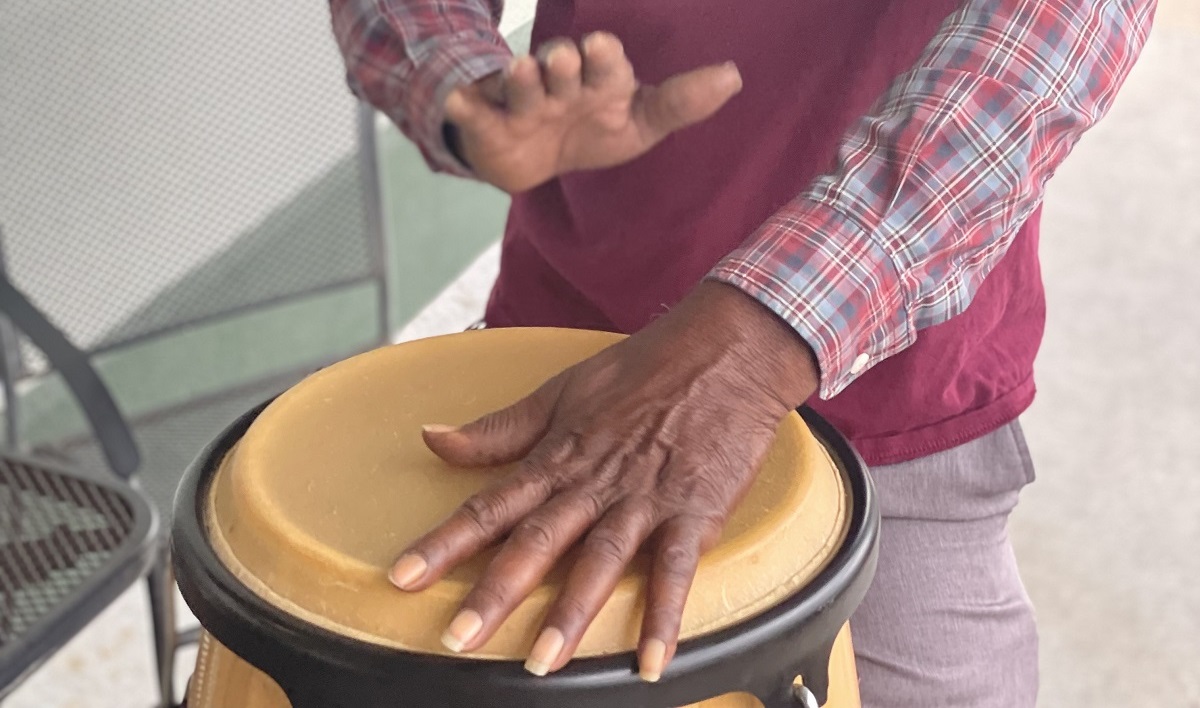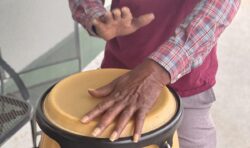October Is Folklife Month
Honoring tradition bearers and those who preserve Louisiana culture
Published: August 30, 2022
Last Updated: November 29, 2022

Photo by Jonathan Foret
Nelson Harris drumming.
Mary Alice Vanderwaters
Songwriter, Musician
Pineville
Folklife Ambassador: Tommy Ike Hamilton
Mary Alice Vanderwaters is a singer and songwriter born and raised in Pineville, Louisiana. At age 7, she begged her brother Max to let her play his guitar; he didn’t take her seriously until she made her own guitar out of a piece of board and some rubber bands. Upon seeing the makeshift guitar, he recognized her determination and taught her to play a song. Years later, Mary Alice wrote the song “Board and the Rubberband Song” as a tribute to Max. Mary Alice joined her first bluegrass band as a teenager and began writing songs after becoming a fan of Dolly Parton and learning to play her songs. She continues to hone her songwriting as a long-time member of the Nashville Songwriting Association and performs today at songwriting rounds, churches, and festivals.
Chef Andrew Miller
Bananas Foster Bread Pudding
New Orleans
Folklife Ambassador: Mona Lisa Saloy
Born in New Orleans and raised in “The Cutoff” section of Algiers, Andrew “Chef Drew” Miller learned how to create food with lots of love from the best chef he knew: his late mother, Eleanor B. Miller. Acting on his passion for cooking, Chef Drew studied the art of cuisine at Sclafani’s Cooking School and soon began working in the field, holding positions as an offshore chef preparing meals for offshore crew members and on-site staff and a sous-chef for the Hilton Garden Inn hotel. In 2000, Chef Drew started Miller Thyme Catering. When he wanted to add something sweet to the menu, he thought of bread pudding. After experimenting with the recipe and adding his own flair, Bananas Foster Bread Pudding was born. It quickly became a signature menu item and one of his most sought-after dishes; Louisiana Poet Laureate Mona Lisa Saloy was so impressed with it (and its effect on diners) that she honored Miller and his dish with a poem.
Alton Armstrong
Mardi Gras Costumes
Lafayette
Folklife Ambassadors: Pudd Sharp, Herman Fuselier
Alton “Lil’ Tiger” Armstrong, originally from the McComb-Veazey neighborhood in Lafayette, has been participating in the Creole Mardi Gras box hat and screen mask tradition since 1969. Lafayette’s oldest Creole Mardi Gras masking and performance tradition features vibrantly colored costumes, usually with a painted wire mask and square mortarboard-style hat made of cardboard, featuring strands of crepe paper streamers as part of the decoration. These incredible costumes often feature shiny satin fabric, colorful feathers, intricate beadwork or embroidery, and noise-making elements such as bells or clappers. Each costume takes hundreds of hours, as well as hundreds of dollars, to complete and is typically only worn for one year before being retired or repurposed for a new costume. Armstrong is one of the few remaining participants in this tradition, which he is attempting to pass along to new generations, including his grandsons. “I’d love to see twenty guys in a group, parading the neighborhood like they used to, all in box hats and screen masks,” Armstrong says.
Lonnie “Butch” Cooksey Jr.
Musician, Producer, Promoter
Independence
Folklife Ambassador: Jim Hogg
From the age of eight, Lonnie “Butch” Cooksey Jr. played guitar in his family gospel and bluegrass band, The Cooksey Family. His mother’s vocation as a Pentecostal preacher opened doors for them to sing in churches and travel for many years. Even though Cooksey has played and recorded with many artists, like Bill Monroe, Ralph Stanley, and Mac Wiseman, he chose to remain with his family band instead of joining a traveling band. Throughout his 63-year career, he has become both an inspiration and a sustaining resource to young people learning this traditional musical form and the instruments it uses: banjo, mandolin, guitar, fiddle, and dobro. Cooksey, in addition to winning many awards for upright bass performance, is also a successful sound technician, supporting performances at bluegrass festivals, churches, and other venues in Louisiana, Oklahoma, Arkansas, Texas, and surrounding areas.
Nelson Harris
Drumming
Houma
Folklife Ambassador: Jonathan Foret
When he was in his twenties, Nelson Harris came across Melvin Williams drumming in a park, and he invited Harris to try his hand at drumming on congas. From that point on, Williams became his teacher. Since then, Harris has become well known in Terrebonne Parish for playing bongo and conga drums in both traditional and African styles. He recalls playing on cowhide heads before synthetic heads were readily available. Because of the force needed to play on cowhide, his hands would often crack and bleed after a session of playing. When asked how drumming makes him feel, Harris said, “When I’m playing drums, I can actually hear it coming off the walls. I can hear it coming off the floors. I can hear the ringing in it. I can play so many different ways, that a lot of times, I try to capture that in one sound, and it’ll lose me, so I chase it.” Now 72, Harris has turned his passion for drumming into a way to give back to his community, volunteering to play at charitable events and spending many hours sharing his love of music through educational workshops for children.
Rhonda Remedies Gauthier
Natchitoches
Mestiza Foodways, Gardening, Sewing, Healing, and Midwifery
Folklife Ambassador: Shane Rasmussen
An Adeasonos and member of the Choctaw-Apache Tribe of Ebarb, Louisiana, and president of Ho Minti Society, Inc., Rhonda Gauthier grew up outside of Zwolle. As a young girl she began learning traditional arts from the women in her immediate and extended family, including crochet, embroidery, hand sewing, quilting, cooking, baking, and animal tending. Her grandmother taught her midwifery, the use of natural herbs to treat common ailments, and herb gardening. After earning a BA in anthropology and history from Northwestern State University, she pursued a successful career in historical interpretation and cultural preservation at various sites across northwestern Louisiana and has continued to volunteer after retirement. In 2005 she produced the film Maize to Masa, which documents the Choctaw-Apache process of nixtamalization, a traditional maize preparation process in which dried kernels are cooked and steeped in an alkaline solution, usually water and food-grade lime, to make hominy. The Choctaw-Apache community still uses this process to make tamale dough.
